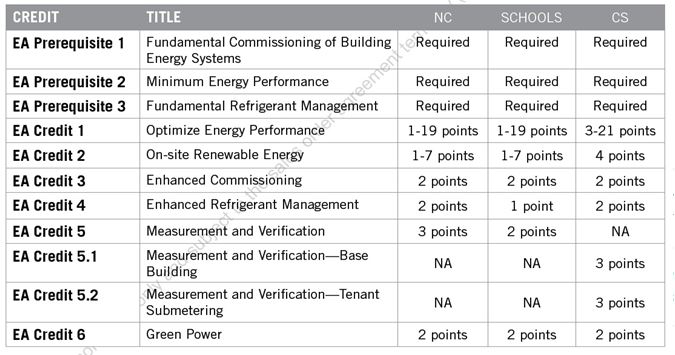استفاده و کاربرد انرژی تجدید پذیر:
گروه های فنی ساختمانی دارای دو روش ترکیب برای استفاده از انرژی های تجدید پذیر را در پروژه LEED می باشند.: استفاده از سیستم های انرژی تجدیدپذیر On-site و خرید برق سبز Off-site. پروژه ها می توانند بصورت ترکیبی عمل نمایند بطوریکه ترکیبی از نیروی الکتریکی on-site ( فتوولتائیک، بادی، آبی ، موج، جذر و مد و مبتنی بر سوخت های بیومس ) ، زمین گرمائی ( آب و بخار زمین در اعماق زیاد) ، و یا حرارت خورشیدی ( مانند منبع و کلکتورهای خورشیدی ) بکار گرفته شوند
تولید انرژی از منابع تجدید پذیر - مانند انرژی خورشیدی، باد و بیومس (زیست توده) – از آلودگی آب و هوا و دیگر پیامدهای زیست محیطی در مقایسه با تولید و مصرف فسیلی و سوخت هسته ای جلوگیری می کند. اگرچه برق تولید شده توسط توربین آبی را می توان جزء انرژی های تجدید پذیر نیز درنظر گرفت، اما می تواند اثرات زیست محیطی زیانباری مانند تحت تاثیر قرار دادن کیفیت آب ، تغییر در زیستگاه های ماهی ها و پرندگان ، و به خطر انداختن گونه های موجودات داشته باشد. البته درصورت موجود بودن برق تولید شده از توربین آبی با اثرات منفی کم ، توصیه می شود.
انرژی های تجدید پذیر موجب به حداقل رسیدن اثرات منفی باران اسیدی، مه دود، تغییر آب و هوا، و مشکلات سلامتی انسان که ناشی از آلودگی هوا است می باشد. علاوه بر این، با استفاده از منابع تجدید پذیر ازمصرف سوخت های فسیلی، تولید زباله های هسته ای، و عملیات سازگار با محیط زیست مخرب سد برق آبی جلوگیری می گردد .
انرژی های تجدید پذیر قابل جایگزین با انرژی های دیگر ممکن است ارزان تر از برق سنتی در برخی از مناطق باشد. عرضه ابزار و سوبسید و تسهیلات عمومی از جانب دولت ها امکان کاهش هزینه های اولیه خرید و نصب تجهیزات انرژی های تجدید پذیر را فراهم می سازد. در برخی از ایالت های آمریکا، برآوردهای خالص می تواند در محل هزینه های انرژی های تجدید پذیر جبران شود بطوریکه برق اضافی تولید شده در سایت به فروش می رسد.
مسائل اقتصادی :
درصورتیکه راه اندازی قبلا مطابق بخشی از برنامه و مراحل تحویل پروژه صورت نگرفته باشد، هزینه های مربوط به راه اندازی ممکن است با هزینه های اولیه ای که منافع بلند مدت را تحت تاثیر قرار می دهد روبرو شود . با این حال راه اندازی را می توان به عنوان یک روش مقرون به صرفه برای اطمینان حاصل شدن از اینکه ساختمان در حال حاضر بگونه ای که طراحی شده است و برای صرفه جوئی برنامه ریزی شده است، در بهره برداری ساختمان تحویل داده می شود.
سلامت ساکنان و بهبود بهره وری از دیگر مزایای بالقوه می باشد، که عملکرد سیستم های ساختمان در نظر گرفته شده است. راه اندازی مناسب از سیستم های ساختمان می تواند بیماری کارمندان و مسئولیت های مربوط به کیفیت هوای داخل ساختمان را کاهش دهد و می تواند از جایگزین کردن خرابی غیر قابل پیش بینی تجهیزات جلوگیری نماید
Using Renewable Energy
Teams have two opportunities to integrate renewable energy strategies into the LEED project: using on-site renewable energy systems and buying off-site green power. Projects can integrate systems that incorporate on-site electrical (photovoltaic, wind, hydro, wave, tidal, and biofuel- based), geothermal (deep-earth water or steam), or solar thermal (including collection and storage components) power. Credit for off-site renewable green power is achieved by contracting for a minimum purchase of green power.
Energy generation from renewable sources—such as solar, wind, and biomass—avoids air and water pollution and other environmental consequences associated with producing and consuming fossil and nuclear fuels. Although hydropower is considered renewable, it can have harmful environmental effects, such as degrading water quality, altering fish and bird habitats, and endangering species. Low-impact hydropower, if available, is recommended.
Renewable energy minimizes acid rain, smog, climate change, and human health problems resulting from air contaminants. In addition, using renewable resources avoids the consumption of fossil fuels, the production of nuclear waste, and the environmentally damaging operation of hydropower dams.
Renewable alternatives may be less expensive than traditional power in some areas. Utility and public benefit fund rebates may be available to reduce the initial cost of purchasing and installing renewable energy equipment. In some states, net metering can offset on-site renewable energy costs when excess electricity generated on site is sold back to the utility.1. Benefits and issues to Consider
Benefits of commissioning include reduced energy use, lower operating costs, fewer contractor callbacks, better building documentation, improved occupant productivity, and verification that the systems perform in accordance with the owner’s project requirements.Environmental issues
Facilities that do not perform as intended may consume significantly more resources over their lifetimes than they should. Commissioning can minimize the negative impacts buildings have on the environment by helping verify that buildings are designed and constructed to operate as intended and in accordance with the owner’s project requirements. Economic issues
If commissioning has not been previously included as part of the project delivery process, the costs associated with commissioning may be met with initial resistance. When the long-term benefits are taken into consideration, however, commissioning can be seen as a cost-effective way to ensure that the building is functioning as designed and that planned energy savings are realized in the operation of the building.
Improved occupant well-being and productivity are other potential benefits when building systems function as intended. Proper commissioning of building systems can reduce employee illness, tenant turnover and vacancy, and liability related to indoor air quality, and it can avoid premature equipment replacement.





 تلفن: 66420090 - 021
تلفن: 66420090 - 021 فکس: 66915315 - 021
فکس: 66915315 - 021 info@bernoulli.ir
info@bernoulli.ir